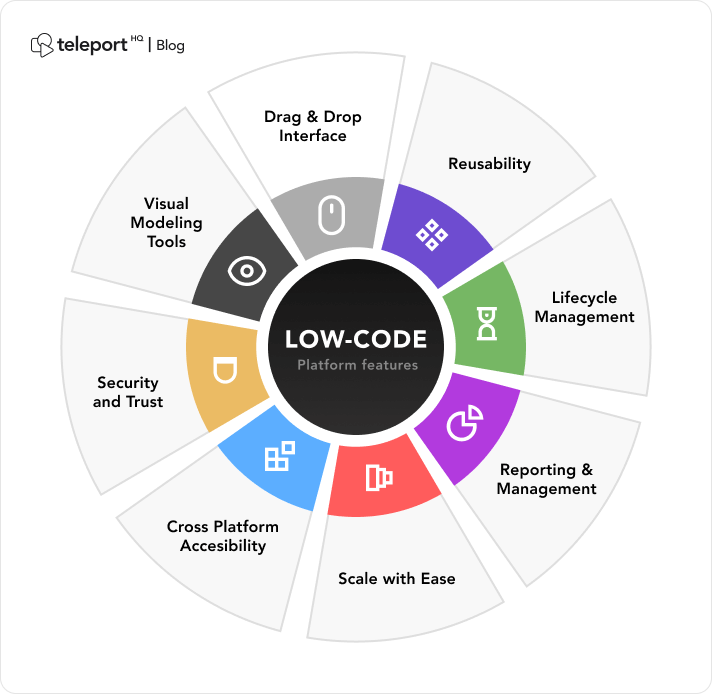Handy Suggestions On Picking application development with Low-code platforms
Handy Suggestions On Picking application development with Low-code platforms
Blog Article
The Advantages Of Low-Code Development For Speed
Low-code application development significantly enhances development speed due to several important factors. Development Environment:
Drag-and-Drop Interfaces: Low-code platforms provide visual tools for designing applications. Drag-and-drop elements allow developers to quickly build applications, without needing to write code.
A lot of low-code platforms come with prebuilt templates and components. This allows developers to quickly develop or prototype their applications, without needing to start from scratch.
Reduced Coding Requirements
Automated Code Generation: The low-code platform generates the code beneath based on the visual models created by developers. This reduces the need to code manually and accelerates the development process.
Reusable Parts: Developers will have the ability to reuse reusable components across projects and reduce the time needed for writing and testing code.
Collaboration can be streamlined.
Integrated Development Tools: Low-code platforms usually come with tools for version control, testing, and deployment, facilitating seamless collaboration among development teams.
Citizen Development: Users of businesses as well as non-developers can contribute to application development using intuitive interfaces, thus reducing bottlenecks often caused by limited access to professionals.
Rapid Iteration and Prototyping:
Rapid Prototyping. Developers can create prototypes in a short time to validate their ideas and receive feedback. This will lead to a more efficient iteration.
Simple Modifications: Low-code development is visual-oriented, making it much easier to modify and update applications. It also speeds the process of developing and improving applications based on user feedback.
Pre-built Integrations:
API Integrations. Many low-code platforms include connectors that are designed to work with popular APIs and services. This could reduce the time to integrate systems.
Data Integration: The instruments that are built into the software simplify and accelerate the process of linking databases, other data sources, and applications.
Scaling, deployment and deployment:
One-Click Deployment: Many low-code platforms have the option of deploying with one click, drastically decreasing the amount of time and effort needed to deploy applications.
Cloud-based solutions: Cloud low-code platforms are capable of handling scale and infrastructure management. Developers can then focus on the application logic and functionalities instead of deployment logistics.
Overall, the advantage of developing low-code applications in terms speed lies in its ability to automatize and simplify many elements of the process, which allows for faster delivery of applications and more rapid adaptation to evolving requirements. Check out the best see post on Low-code Platform for application development for blog advice including app platforms, develop mobile application, push notifications android, develop web application, microsoft azure sql, software for app development, low code development platforms, develop cross platform mobile app, lowcode no code, build a docker container and more.
Flexibility And Scalability Are The Two Main Advantages Of Developing Applications Using Low-Code
Low-code development offers numerous advantages in regards to scalability and flexibility essential to building applications that are able to grow and adapt to the changing needs of business. Here are the key advantages: Rapid Scaling
Cloud-based deployment. Many low-code platforms feature a cloud-based deployment that allow users to easily scale their applications using cloud infrastructure. This allows businesses to handle increased loads without worrying about managing servers.
Auto-Scaling Features: Auto-scaling functions built-in can automatically adjust resources according to demand, which ensures the same performance even during peak hours without any manual intervention.
Flexible Architecture:
Modular design: Low-code platforms are a fantastic way to encourage modular applications. These allow components to be designed and developed on their own, tested, scaled or even resized. This modularity improves flexibility and enables easier modifications or expansions to specific parts without impacting the whole system.
Microservices Integrate: Microservices enable applications to grow and become flexible by allowing them to be constructed as a group of loosely connected services.
Custom-designed solutions:
Extensibility Low-code platforms typically allow custom coding and scripting. This lets developers expand the functionality of applications beyond the capabilities that are available in the box. This allows for unique business needs to be met with no restrictions.
Third-Party Integrations: Businesses are able to integrate additional functionality and services into their apps through APIs and other third-party services.
Agile Development and deployment:
Continuous Delivery and Deployment Low-code Platforms can support agile methods through enabling continuous integration and Continuous Delivery (CI/CD). This allows for the rapid deployment and updating of features.
Iterative Design: Since low-code is an iterative procedure the applications can be gradually improved and enlarged. This permits controlled growth and reduces the risk of massive changes.
Resource Optimization
Efficiency in Resource Management: Low-code systems help optimize resource usage by providing tools for monitoring and managing the performance of applications. This makes sure that resources are used efficiently and are scalable according to the needs of the user.
Load-balancing: The program is able to handle large volumes of traffic with ease and consistency because of the integrated load-balancing capabilities.
Global Reach
Multi-Region Availability: Lowcode platforms allow to be used across a variety of regions. Companies can provide users with low-latency worldwide access. This is particularly important when applications have an international user base.
Support for Localization. Inbuilt support for localizing applications lets them be easily adapted to different local languages, regional needs and improves their flexibility in various markets.
Maintenance and Updates
Simplified maintenance: The graphic and module nature of low-code software makes it easy to perform the maintenance tasks. They permit updates and bugs corrections to be carried out quickly without extensive downtime.
Version Control: The integrated version control system helps control changes and roll backs. This ensures that updates are easily installed and older versions restored if required.
Cost Efficiency:
Low Development Costs. By reducing coding requirements, low-code platforms cut down on the development cost and permit applications to be scaled up without increasing development efforts.
Pay-As You-Go Models: Many low-code platforms provide flexible pricing models, including pay-as-you-go, which align costs with usage and growth, allowing the flexibility to finance.
Low-code development offers businesses many advantages, including scalability, flexibility and flexibility. This enables them to develop robust, flexible and scalable apps. These platforms permit rapid changes to meet changing demands as well as efficient utilization of resources and continual enhancement. Applications can grow and adapt to the changing needs of business. See the best additional info on Legacy application modernization with Low-code for site info including application modernization, sso azure, stored sql procedures, application development platforms, azure sql databases, rad application development, build with docker, mobile app development platforms, build with docker, build a docker container and more.
Benefits Of Developing Applications Using Low-Code In Terms Of Vendor Support And Community
Low-code platforms offer significant advantages both in terms of community involvement and vendor support and vendor support, both of which are vital to successful implementation, maintenance, and further improvement of software. Here are the key benefits:Vendor Support
Comprehensive Technical Support:
Support Teams: Many platforms that make use of low-code offer dedicated support teams to assist with technical problems, troubleshooting and guidance.
24/7 Support Availability: Some suppliers provide support 24/7 that is especially beneficial for global businesses operating across different time zones.
Training and Onboarding
Vendors often provide user-friendly programs like tutorials and webinars. They may also provide certificates.
Personalized onboarding: Many companies offer customized services for customers who are new helping them to set up the platform properly and to customize it to meet their specific needs.
Regular Updates and Enhancements
Continuous Improvement: Low-code platforms release regular updates, which include updates to features, security patches and improvements to performance. This makes sure that the platform is always current and safe.
Feedback Integration: A lot of vendors incorporate user input into their development cycles. This helps ensure that the platform can adapt to the evolving requirements and desires of its users.
Comprehensive Documentation:
Documentation - In depth: A comprehensive and well-organized documentation that covers everything from basic usage to advanced modifications, is often available. This allows users to solve problems independently.
API References Comprehensive API documentation enables developers to create custom applications and integrate low-code platforms into other systems.
Consultation and Professional Services:
Expert Consulting: A lot of firms offer consulting services that help users with complex implementations and designs for architecture and also strategic planning.
Custom Development: Some vendors provide services that permit them to develop specific features, or incorporate systems that aren't offered in the standard version.
Community Support
Active User Communities
Forums and discussion boards A lot of platforms with low-code have vibrant online community for users to seek help, share solutions and collaborate in finding the most efficient practices.
Local and virtual User Groups, as well as Meetups, provide opportunities for users to discuss their experiences, learn from other users, and connect with.
Collaboration and Knowledge Sharing:
Community-Contributed Resources: Users often share templates, modules, and extensions that they have developed, which can be reused or adapted by others, accelerating development and innovation.
Crowdsourced Solutions: The collective experience and experience of a group can prove to be a useful tool in problem-solving and finding innovative solutions.
Learning and Development
Community-led Training: Many groups organize workshops, training sessions and webinars. They are usually conducted by experts in the field, who share practical knowledge as well as advanced techniques.
Tutorials and Online Courses: Community members frequently create and share online tutorials, courses, and guides on how-to, which enhance the resources for learning available to all users.
Feedback and Influence
Product Feedback: Many community forums have channels for giving feedback to manufacturers. This can influence the design of new features or improvements.
Beta Testing Programmes Members of the community who are active could have the opportunity of participating in beta programs. This gives them an early view on new features as well as a chance to help shape the platform’s evolution.
Recognition and Support
Community Recognition Programs: A lot of companies offer recognition programs to active members of the community. Examples include MVP (Most Valuable Professionals) that recognizes contributions of the community.
Peer Support: Community members give support to each other by sharing their experiences and providing guidance. They help create a cooperative and supportive atmosphere by sharing knowledge.
Overall, the combination of strong support from the vendor with a vibrant and active community provides a comprehensive support eco-system for low code application development. The users will have the expertise and resources they need to develop, deploy and maintain their application.